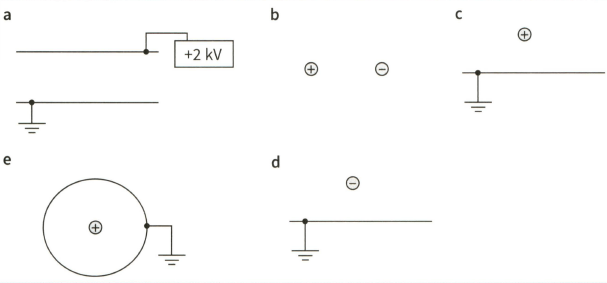The electric field strength $20 \mathrm{~cm}$ from an isolated point charge is $1.9 \times 10^{4} \mathrm{NC}^{-1}$
What is the electric field strength $30 \mathrm{~cm}$ from the charge?
(a)
(b)
(c)
(d)

Important Questions on Coulomb's Law
On a copy of this diagram, draw the electric fields between the charged objects.

Two parallel plates are $4 \mathrm{~cm}$ apart and have a potential difference of $2.5 \mathrm{kV}$ between them. Calculate the electric field strength between the plates.
Two parallel plates are $4 \mathrm{~cm}$ apart and have a potential difference of $2.5 \mathrm{kV}$ between them. A small piece of dust carrying a charge of $+2.4 \mathrm{nC}$ moves into the space between the plates. Calculate the force on the dust particle.
Two parallel plates are $4 \mathrm{~cm}$ apart and have a potential difference of $2.5 \mathrm{kV}$ between them. A small piece of dust carrying a charge of $+2.4 \mathrm{nC}$ moves into the space between the plates. The mass of the dust particle is $4.2 \mathrm{mg}$. Calculate the acceleration of the particle towards the negative plate.
A small sphere carries a charge of $2.4 \times 10^{-9} \mathrm{C}$. Calculate the electric field strength at a distance of:
(a) $2 \mathrm{~cm}$ from the centre of the sphere.
A small sphere carries a charge of $2.4 \times 10^{-9} \mathrm{C}$. Calculate the electric field strength at a distance of $4 \mathrm{~cm}$ from the centre of the sphere.
A conducting sphere of diameter $6.0 \mathrm{~cm}$ is mounted on an insulating base. The sphere is connected to a power supply that has an output voltage of $20 \mathrm{kV}$.
(a) Calculate the charge on the sphere.
A conducting sphere of diameter $6.0 \mathrm{~cm}$ is mounted on an insulating base. The sphere is connected to a power supply that has an output voltage of $20 \mathrm{kV}$.
(b) Calculate the electric field strength at the surface of the sphere.
